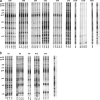Viral phenotypes and antibody responses in long-term survivors infected with attenuated human immunodeficiency virus type 1 containing deletions in the nef and long terminal repeat regions
- PMID: 17567690
- PMCID: PMC1951448
- DOI: 10.1128/JVI.00650-07
Viral phenotypes and antibody responses in long-term survivors infected with attenuated human immunodeficiency virus type 1 containing deletions in the nef and long terminal repeat regions
Abstract
The Sydney Blood Bank Cohort (SBBC) consists of eight blood transfusion recipients infected with nef-attenuated human immunodeficiency virus type 1 (HIV-1) acquired from a single donor. Here, we show that viral phenotypes and antibody responses differ considerably between individual cohort members, despite the single source of infection. Replication of isolated virus varied from barely detectable to similar to that of the wild-type virus, and virus isolated from five SBBC members showed coreceptor usage signatures unique to each individual. Higher viral loads and stronger neutralizing antibody responses were associated with better-replicating viral strains, and detectable viral replication was essential for the development of strong and sustained humoral immune responses. Despite the presence of strong neutralizing antibodies in a number of SBBC members, disease progression was not prevented, and each cohort member studied displayed a unique outcome of infection with nef-attenuated HIV-1.
Figures


Similar articles
-
Phenotype and envelope gene diversity of nef-deleted HIV-1 isolated from long-term survivors infected from a single source.Virol J. 2007 Jul 16;4:75. doi: 10.1186/1743-422X-4-75. Virol J. 2007. PMID: 17634131 Free PMC article.
-
Persistence of attenuated HIV-1 rev alleles in an epidemiologically linked cohort of long-term survivors infected with nef-deleted virus.Retrovirology. 2007 Jul 1;4:43. doi: 10.1186/1742-4690-4-43. Retrovirology. 2007. PMID: 17601342 Free PMC article.
-
Lymphoproliferative immune function in the Sydney Blood Bank Cohort, infected with natural nef/long terminal repeat mutants, and in other long-term survivors of transfusion-acquired HIV-1 infection.AIDS. 1997 Nov;11(13):1565-74. doi: 10.1097/00002030-199713000-00004. AIDS. 1997. PMID: 9365760
-
The Sydney Blood Bank Cohort: implications for viral fitness as a cause of elite control.Curr Opin HIV AIDS. 2011 May;6(3):151-6. doi: 10.1097/COH.0b013e3283454d5b. Curr Opin HIV AIDS. 2011. PMID: 21378562 Review.
-
The tat gene and protein of the human immunodeficiency virus type 1.New Microbiol. 1995 Jan;18(1):87-110. New Microbiol. 1995. PMID: 7760763 Review. No abstract available.
Cited by
-
Heavily glycosylated, highly fit SIVMne variants continue to diversify and undergo selection after transmission to a new host and they elicit early antibody dependent cellular responses but delayed neutralizing antibody responses.Virol J. 2008 Aug 4;5:90. doi: 10.1186/1743-422X-5-90. Virol J. 2008. PMID: 18680596 Free PMC article.
-
Macrophage Tropism and Cytopathicity of HIV-1 Variants Isolated Sequentially from a Long-Term Survivor Infected with nef-Deleted Virus.Open Microbiol J. 2007;1:1-7. doi: 10.2174/1874285800701010001. Epub 2007 Jun 25. Open Microbiol J. 2007. PMID: 19088897 Free PMC article.
-
Short communication: neutralizing antibodies in HIV-1-infected Brazilian individuals.AIDS Res Hum Retroviruses. 2013 Mar;29(3):488-92. doi: 10.1089/AID.2012.0052. Epub 2012 Dec 18. AIDS Res Hum Retroviruses. 2013. PMID: 23145941 Free PMC article.
-
Continuous viral escape and selection by autologous neutralizing antibodies in drug-naive human immunodeficiency virus controllers.J Virol. 2009 Jan;83(2):662-72. doi: 10.1128/JVI.01328-08. Epub 2008 Nov 5. J Virol. 2009. PMID: 18987151 Free PMC article.
-
HIV-1 Nef: at the crossroads.Retrovirology. 2008 Sep 22;5:84. doi: 10.1186/1742-4690-5-84. Retrovirology. 2008. PMID: 18808677 Free PMC article. Review.
References
-
- Baba, T. W., Y. S. Jeong, D. Pennick, R. Bronson, M. F. Greene, and R. M. Ruprecht. 1995. Pathogenicity of live, attenuated SIV after mucosal infection of neonatal macaques. Science 267:1820-1825. - PubMed
-
- Binley, J. M., T. Wrin, B. Korber, M. B. Zwick, M. Wang, C. Chappey, G. Stiegler, R. Kunert, S. Zolla-Pazner, H. Katinger, C. J. Petropoulos, and D. R. Burton. 2004. Comprehensive cross-clade neutralization analysis of a panel of anti-human immunodeficiency virus type 1 monoclonal antibodies. J. Virol. 78:13232-13252. - PMC - PubMed
-
- Birch, M. R., J. C. Learmont, W. B. Dyer, N. J. Deacon, J. J. Zaunders, N. Saksena, A. L. Cunningham, J. Mills, and J. S. Sullivan. 2001. An examination of signs of disease progression in survivors of the Sydney Blood Bank Cohort (SBBC). J. Clin. Virol. 22:263-270. - PubMed
-
- Bradney, A. P., S. Scheer, J. M. Crawford, S. P. Buchbinder, and D. C. Montefiori. 1999. Neutralization escape in human immunodeficiency virus type 1-infected long-term nonprogressors. J. Infect. Dis. 179:1264-1267. - PubMed
-
- Brambilla, A., L. Turchetto, A. Gatti, C. Bovolenta, F. Veglia, E. Santagostino, A. Gringeri, M. Clementi, G. Poli, P. Bagnarelli, and E. Vicenzi. 1999. Defective nef alleles in a cohort of hemophiliacs with progressing and nonprogressing HIV-1 infection. Virology 259:349-368. - PubMed
Publication types
MeSH terms
Substances
Grants and funding
LinkOut - more resources
Full Text Sources
Medical

